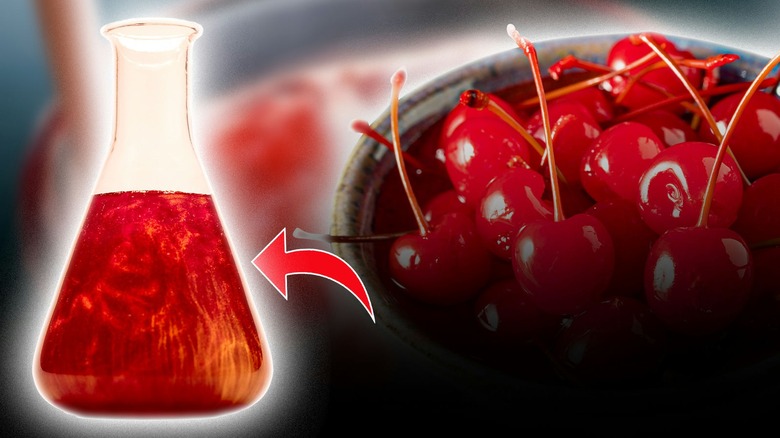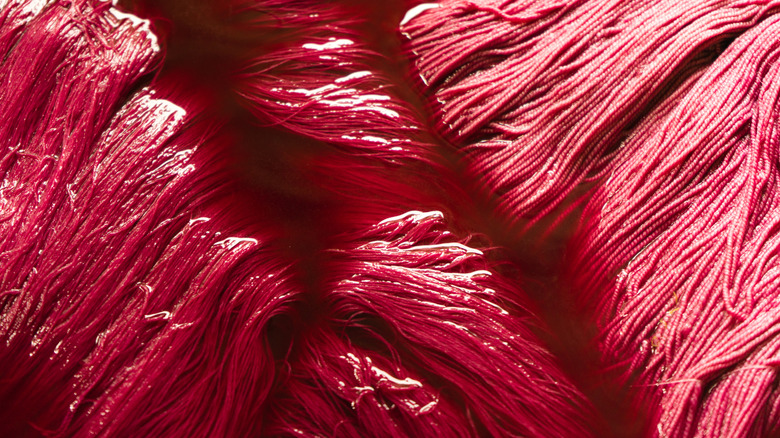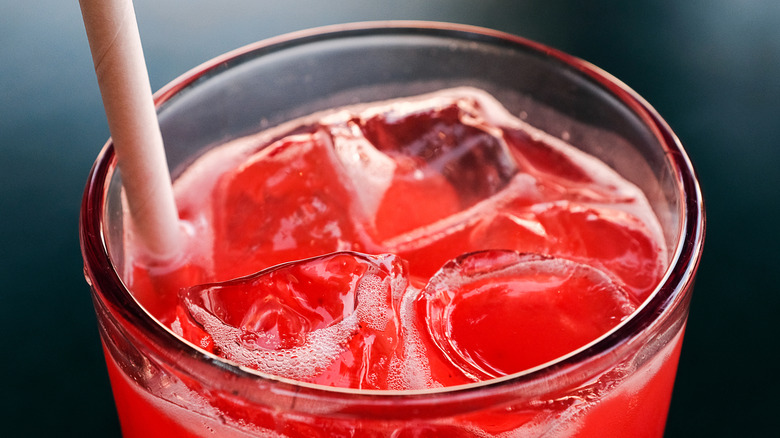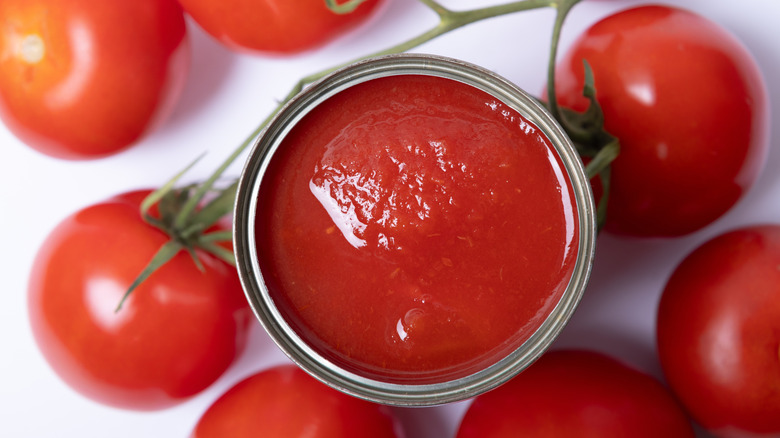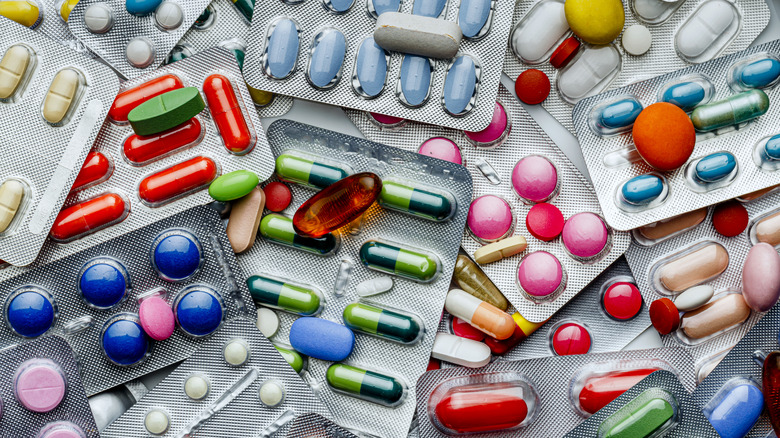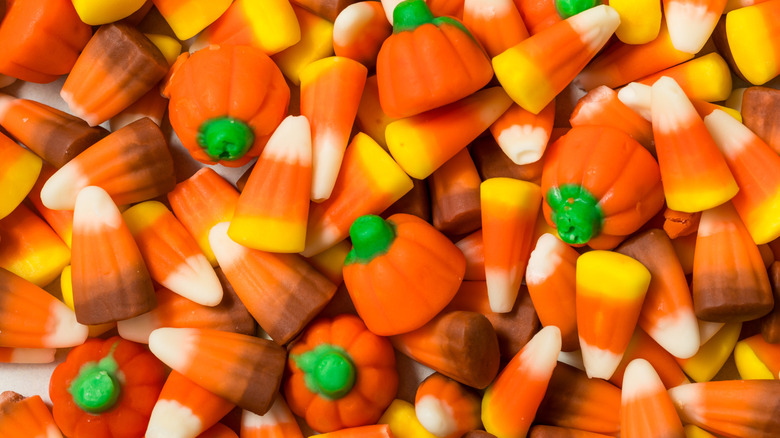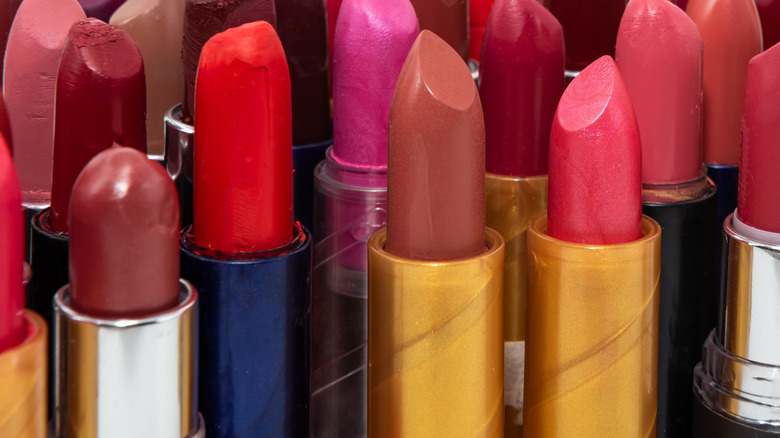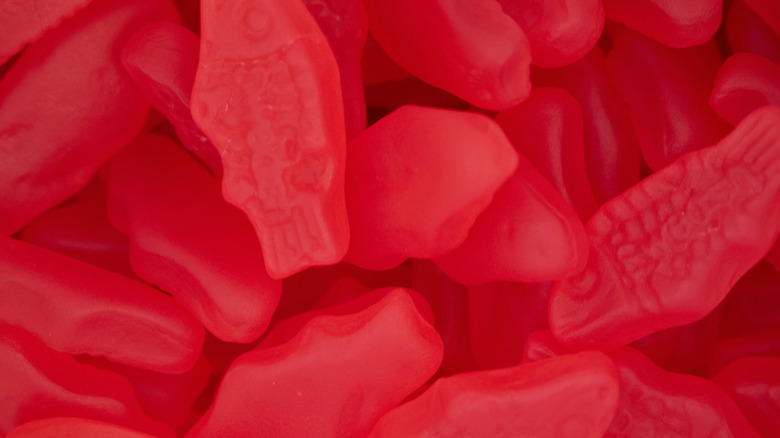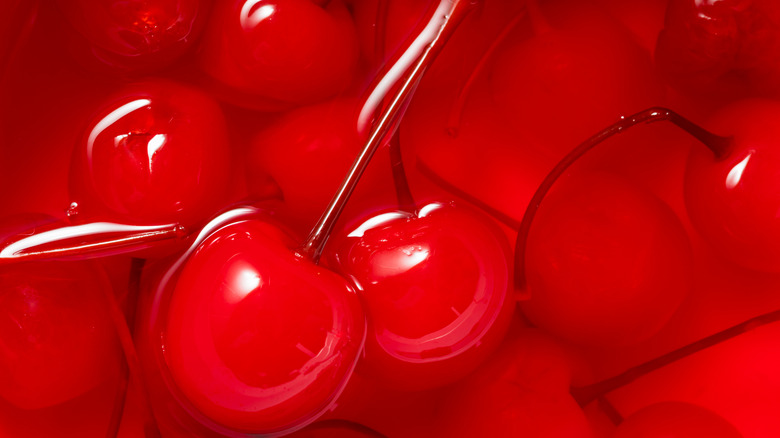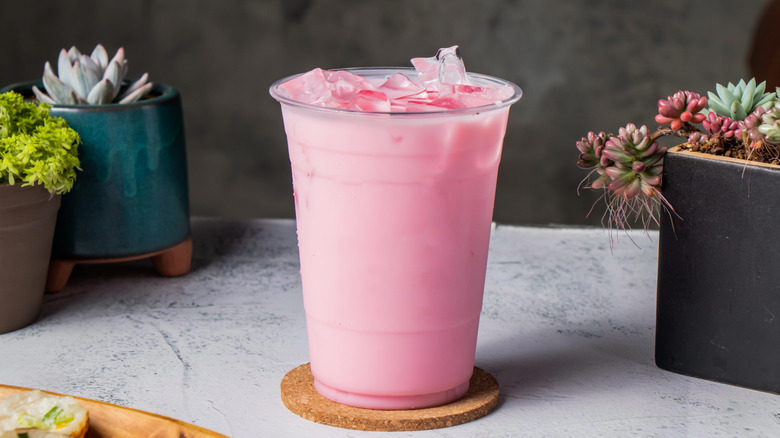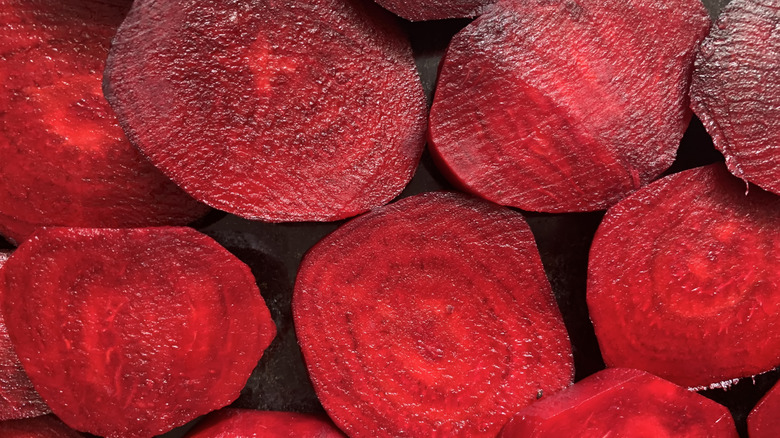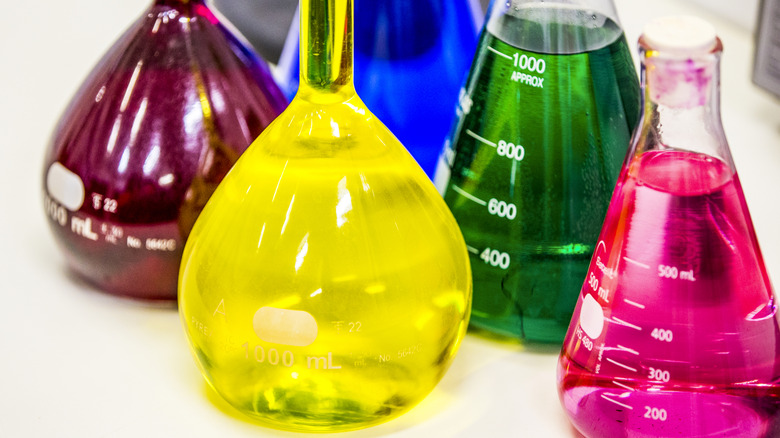The Complete History Of Red Dye No. 3 In Food
When red dye No. 3 was federally outlawed in the U.S. on January 15, 2025, it marked a turning point for future food production on the domestic market. The popular red dye — also called Red No. 3, FD&C Red No. 3, Erythrosine, E127, and Red 3 — is a known carcinogen, but it's been brightening up our food for over a century.
If you were unmoved by the news, you're not alone. To some degree, Americans have been conditioned to accept widespread use of artificial dyes in food as an inevitable fact of modern life. Now that the U.S. has enacted a Red No. 3 ban, it makes us wonder how this synthetic dye got into food in the first place.
Japan, China, Australia, New Zealand, and a host of European nations shifted away from using Red No. 3 in processed foods years ago. The U.S. — not so much. One of the biggest problems with Red No. 3 is its prevalence in breakfast cereals and candy marketed toward kids. Marketing harmful chemicals to impressionable youth presents some obvious fundamental flaws, yet the U.S. has been slow to remedy the situation.
Red No. 3 has been singled out due to its cancer-causing properties, but most of the artificial dyes regularly used in processed food come with their own set of adverse health effects. So far, it's red dye that's gotten the thumbs down from federal health officials, but Red No. 3 didn't go from hot to not overnight. This is how it went down.
Red Dye No. 3 was invented in 1876
In 1876, Swiss chemist Karl Kussmaul developed Red No. 3 inside a University of Basel laboratory in Switzerland. Kussmaul's creation was known as erythrosine, named for the ancient Greek word "eruthrós", meaning "red". Upon its inception, erythrosine caught the attention of commercial textile dyers Bindschedler & Busch. The Swiss partnership began manufacturing erythrosine for the purpose of dyeing silk and wool.
According to Bindschedler & Bush's entry in "Le Moniteur scientifique du Docteur Quesneville" first published in 1878, erythrosine was made by dissolving fluorescein, an organic fluorescent dye, in alkaline water and combining it with iodine dissolved in a diluted caustic soda. The crystalline substance it formed was mixed with more iodine and other chemicals like potassium dichromate and sulphuric acid – two corrosive and carcinogenic compounds.
Erythrosine was commercialized in an era when synthetic dyes were still in a primitive stage. In 1856, 18-year-old scientist William Henry Perkin, who was studying in Europe under the German organic chemist August Wilhelm von Hofmann, was the first to synthesize a dye. Perkins made a purple-hued dye called mauveine while experimenting with derivatives of coal tar. This discovery kicked off a demand for coal tar dyes in the textile industry. In a decades-long lead-up to the 1906 Pure Food and Drug Act, the U.S. Department of Agriculture (USDA) performed safety testing on synthetic dyes for the purpose of coloring food. Erythrosine passed the test, and was renamed Red Dye No. 3 for the American market.
Controversy around red dye isn't new
Prior to the 1906 Food and Drug Act, artificial colorings made from poisonous chemicals such as arsenic, lead, and mercury were used to tint everyday foods like butter and cheese — sometimes for the purpose of camouflaging product defects. The seven synthetic colors permitted under the Food and Drug Act — which included Red No. 3 — were intended to replace heavy metal food colorings. Eventually, the safety of these novel dyes would also be questioned.
Adulterated or misbranded coal tar dyes were behind some grisly product snafus in the 1920s and '30s, including a toxic eyelash dye that left some women blind. In 1938, the Federal Food, Drug, and Cosmetics Act required all products containing coal tar dyes to list their inclusion on packaging. By the 1970s, Red Dye No. 2, also known as amaranth, was getting some really bad press.
In published reports from 1968 and 1970, Soviet scientists declared that Red No. 2 caused cancer. The U.S. paid attention. Red No. 2 had been around since 1878, but was under such scrutiny that the Mars candy company stopped making red M&Ms even though Red No. 2 wasn't in them. Lab tests to determine whether Red No. 2 caused cancer in rats offered mixed or botched results and created public confusion. In January 1976, the Food and Drug Administration (FDA) banned Red No. 2 for use in food, drugs, and cosmetics. Many manufacturers replaced Red No. 2 in their products with Red Dye No. 40.
What foods is Red Dye No. 3 in?
When we think of Red No. 3 in food, the first thing that comes to mind is candy. There are loads of candies out there that tempt us with their vibrant red hues, but only some of them get their lustrous shade from Red No. 3. The chocolate-coated candy Sixlets, Jordan almonds, candy corns, Mellowcreme pumpkins, conversation hearts, certain gummy candies, Pez, and Dubble Bubble gum all contain Red No. 3 — for now. Other popular red candies like Twizzlers, Swedish Fish, and Haribo gummy candies contain Red No. 40.
In the savory foods category, Red No. 3 has made its way onto the ingredients lists of foods you might not expect. Some cans of tomato sauce, like the brand Iberia, put artificial red color into an already red sauce. Certain plant-based meats are injected with Red No. 3, including the veggie bacon sold by popular meat-free brand MorningStar Farms. Popular rice brand Vigo pairs Red No. 3 with Yellow No. 5 to punch up the brightness of its Saffron yellow rice and Authentic Mexican Rice.
Plenty of pink-colored foods rely on Red No. 3 to heighten their visual appeal. Nesquik Strawberry Milk and Yoo-hoo Strawberry Drink incorporate Red No. 3. So do various strawberry ice creams, yogurts, and shakes. Other dessert-y items are also rife with Red No. 3. Cake icing and sprinkles, Funfetti cake, and some Friendly's ice cream cakes all have Red No. 3 inside.
Red Dye No. 3 is also found in common supplements and medicines
Since Red No. 3's role as a food additive is to enhance the appearance, it's not all that surprising that drug companies use the dye's beatific powers to their benefit. Medicine capsules are sold in quite literally all the colors of the rainbow, but because they aren't food, many consumers overlook the dyes they are coated with. The truth is, numerous pills are pigmented with Red No. 3. These pills range from supplements, to over-the-counter medicine, and prescription medication.
For instance, Red No. 3 is used in the capsule coating of acetaminophen and diphenhydramine hydrochloride, an over-the-counter headache and insomnia medicine sold at Target. The capsule primarily consists of two shades of blue, one light one bright. This is a prime example of Red No. 3 being pulled in as a supporting pigment. In Red No. 3's days as a textile dye in the late 19th century, it was described as emitting a bluish scarlet tone.
The prescription antibiotic doxycycline monohydrate is another example of a capsule that doesn't appear to contain red coloring, but does. The pared-down, mustard yellow shade of doxycycline monohydrate counts FD&C Yellow No. 10, Yellow No. 6, Blue No. 1, and Red No. 3 among its many synthetic additives. Even if you don't regularly take capsule medicines, you might still be consuming Red No. 3 in the name of health. Some gummy vitamins and cough syrups get their crimson color from Red No. 3.
When will the ban take effect?
The FDA's decision to ban Red No. 3 cannot happen immediately. Food manufacturers have until January 15, 2027 to phase Red No. 3 out of any products currently utilizing it. Drug companies will have until January 18, 2028. This grace period allows businesses time to reformulate their goods mindfully, lessening the risk for quality control issues at the retail level. It will also prevent the supply and demand issues that would occur if every Red No. 3-containing product containing was abruptly ripped from the domestic market.
Several companies are already working to expunge the contentious dye from their wares. Keurig Dr Pepper, owner of Yoo-hoo Strawberry Drink, has committed to getting a Red No. 3-free version of the beverage in stores by the end of 2025. Ferrara Candy Company said its seasonal Brach's candies (like candy corns) will be sold without Red No. 3 for the fall of 2025 and all traces of it will be nixed by the end of 2026.
Imported goods made in countries where Red No. 3 isn't banned will need to modify existing recipes for their American customer base. For international companies, this expectation is nothing new. For example, U.S. brand Kellogg's domestically sells breakfast cereals with chemicals that are banned abroad, but tweaks the ingredients in versions sold overseas. Froot Loops in the U.S. contain Yellow No. 5, Blue No. 1, and other synthetic colors. Froot Loops in the U.K. are tinted with fruit and vegetable concentrates.
The FDA has banned Red Dye No. 3 before
The January 2025 ban on Red No. 3 in food is not the first time the Feds have said no thanks to the common colorant. On January 30, 1990, Red No. 3 officially got the boot from the cosmetics industry. The decision was made after laboratory tests showed that rats developed cancer — specifically thyroid tumors — when administered very high doses of Red No. 3. Though the FDA determined that the risk of humans getting cancer after a lifetime of consuming Red No. 3 was one in 100,000, the dye was no longer permitted in lipstick, blushes, powders, and other cosmetic pigments. It was also banned from topical medicines.
At the time, Red No. 3's prevalence in cosmetics and topical meds made up just ⅕ of its commercial uses. The FDA announced an impending ban of Red No. 3 in food and oral drugs in 1992, but it took 35 years after the 1990 regulations to actually happen. Why was Red No. 3 taken out of products we don't ingest and kept inside those we do? Some fingers point to industry pressure. Companies making money from commercial products containing Red No. 3 lacked a concrete incentive to change their ways. The FDA cited a lack of resources as the reason for not taking action.
How is Red Dye No. 3 different from Red Dye No. 40?
Many soft drinks, sweets, breakfast cereals, and other foods get their bright red or pink hues from dye, but it's not always Red No. 3 that's used. More often, Red No. 40 is responsible for that pop of color. In the U.S., Red No. 40, Yellow No. 5, and Yellow No. 6 comprise 90% of the artificial color in over 36,000 retail food products. It's difficult to visually distinguish Red No. 3 from Red No. 40, but there are differences between the two.
Red No. 40, also called Allura Red, E129, Red Dye 40, and FD&C Red 40, is made from petroleum. It was approved for use in food and drugs in the 1970s. Red No. 40 replaced Red No. 3 after its 1990 ban from cosmetics and topical medicines. In the U.S., 94% of people over age two have consumed Red No. 40.
In contrast, Iceland and Norway have outlawed the use of Red No. 40 in foods. The European Union (EU) requires products containing Red No. 40 to have warning labels regarding its potential to cause hyperactivity and attention deficiency in children. The biggest difference between Red No. 40 and Red No. 3 is their perceived cancer risks. Iodinated chemical compounds are known disruptors to healthy thyroid function, and iodine makes up 58% of Red No. 3's molecular weight. Red No. 40 is linked to health problems, too, but its status as a carcinogen is less pronounced.
Internationally, opinions about Red Dye No. 3 are mixed
The U.S. has a reputation for pumping lab-derived additives into countless processed foods — all the more reason why its banishment of Red No. 3 in food feels like a step in the right direction. The decision comes more than 30 years after the EU took Red No. 3 out of commission in 1994. Well, almost. The EU still allows Red No. 3 inside maraschino cherries. As the U.S. joins the company of many nations that promote Red No. 3-free societies, other countries maintain that Red No. 3 isn't as dangerous as it has been made out to be.
One of the more outspoken nations in defense of Red No. 3 is Canada. Red No. 3 is a permitted additive in Canada, something that shows no signs of changing anytime soon. According to the Canadian collective school of thought, the concerns surrounding Red No. 3's carcinogenic properties come from antiquated evidence.
When the FDA banned Red No. 3 in food, it cited the Delaney Clause, a piece of legislation from 1960 prohibiting the use of artificial additives in food if they've been scientifically proven to cause cancer. Canadian health officials acknowledge that high doses of Red No. 3 casing thyroid tumors in rats, yet doubt that the amount of Red No. 3 consumed by humans would produce the same detrimental effects. By that account, it's not significantly more dangerous than the synthetic yellows, blues, and green food colorings the U.S. still allows.
Have people gotten sick from consuming Red Dye No. 3?
The only confirmed cases of cancer caused by Red No. 3 consumption were in male rats. Red No. 3's potential to cause cancer has been the subject of lab testing since the 1980s. While there is no question that Red No. 3 poses imminent risk to the thyroid health of male rats, there are no records of the dye ever causing cancer in a human.
Laboratory data indicating that large doses of Red No. 3 induced thyroid cancer in male rats was referenced in a color additive petition that the Center for Science in the Public Interest submitted to the FDA in 2022. The petition was integral in leading the FDA to revoke Red No. 3's permittance in food and oral medicine. Red No. 3 may not be actively causing cancer in humans, but other data suggests that it can be especially harmful to people who have cancer already.
A lab study by the National Institute of Environmental Health Sciences from 1997 produced some worrying data on Red No. 3. The study found that Red No. 3 increased the growth of HTB-133 cells — also known as T-47D — which are human breast cancer cells. Red No. 3 has stimulatory properties similar to that of the hormone estrogen. Overproduction of estrogen puts the body at a heightened risk for breast cancer.
Natural alternatives will likely replace Red Dye No. 3
For companies that have been using Red No. 3 for years, putting down the dye might be hard, but it's far from impossible. Natural food colorants are favored by many modern food manufacturers. In 2015, grocery mega-chain Aldi removed artificial colors from all of its store brand products. Historic U.S. brand Campbell's declared that all of its soups sold in North America were free of artificial colors and flavors in 2018. There are plenty of highly pigmented elements found in nature, and they have been replacing fake coloring for quite some time. Beets and pomegranates are expected to take Red No. 3's place in food in the near future.
The shift toward cleaner foods and more natural ingredients helps promote healthier choices — even in processed foods. The rich reddish pink hues beets and pomegranates provide are just two of several natural alternatives food companies have. Cochineal dyes, also called carmines, get their rich crimson color from the ground-up bodies of insects. Carmine dye is a well-suited additive for meat because it can sustain changes in temperature and light. It is crucial that the inclusion of natural colors containing insects or animal byproducts is indicated on the food packaging. Not only do cochineal dyes present an allergy risk, but they also make products that could be mistaken as vegan very much not vegan.
Are other artificial colors going to be banned next?
Red No. 3's former privileges as a color additive were revoked solely on the grounds that it has the propensity to cause cancer. To that end, other artificial food colors and other potentially harmful additives could be next on the chopping block. California has been leading the charge in possibly banning or at least heavily limiting the use of chemically derived colorants in food. Under the California School Food Safety Act, which was approved on September 28, 2024, foods served in schools throughout the state must be free of Blue No. 1, Blue No. 2, Green No. 3, Red No. 40, Yellow No. 5, and Yellow No. 6. The legislation takes effect on December 31, 2027.
This sweeping change could gain traction outside of California's borders. Red No. 3 was originally implicated in the California School Food Safety Act, proving that progressions at the state level are outpacing action by the FDA. Studies of Red No. 40, Yellow No. 5, and Yellow No. 6 have not yielded comforting results. Red No. 40 contains the carcinogenic contaminant p-Cresidine, known to emit toxic fumes and irritate the skin and eyes. Yellow No. 5 and Yellow No. 6 contain benzidine and 4-amino-biphenyl, two carcinogens that can cause bladder cancer through oral exposure.
